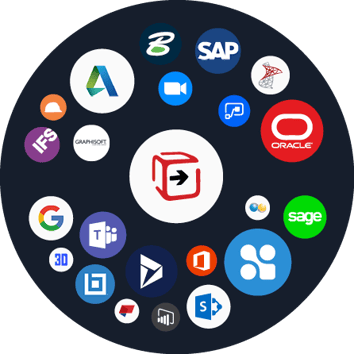
A single construction project involves countless stakeholders—asset owners, project managers, architects, engineers, contractors, sub-contractors, and material suppliers—all from varying disciplines contributing work and deliverables in various formats.
This produces a vast amount of data and information, often unstructured, uncoordinated, and inaccessible. The notoriously fragmented nature of the industry also means that data and insights learned from one project to the next are routinely left by the wayside.
Imagine the BIM model is created by the architect on one software. The time comes for the contractors to view the model and input their data, but they don’t have the same software. Here, either the contractor has to fork out for a new piece of tech, or they are blocked from proceeding.
This type of scenario isn’t unique to BIM or any other software for that matter. According to JBKnowledge’s 2021 Construction Technology Report, more than 24% of construction software applications don’t integrate. The result of this lack of integration? Data silos.
3 Ways Data Silos Cost Your Projects
When unintegrated tools keep valuable project data hostage, it becomes unstructured, uncoordinated, and inaccessible. Here’s how this can be detrimental to your project:
1. Impacts Your Bottom Line
One of the highest priorities for any project is keeping costs down. However, each year millions are wasted due to errors, inefficiency, and low productivity—all of which can be introduced by data silos.
As you can imagine, this has a significant impact on profits.
According to research, a lack of efficiency in construction could add between 20%-25% to the cost of a project. For U.S. projects valued at $2 billion, this could mean an increase of between $400 million and $500 million. In the UK, projects with a construction value of £250 million could see an increased cost of £50 million and £62.5 million.
2. Steals Your Valuable Time
When it comes to transferring data where integrations don’t exist, 49% of construction professionals do it manually. Of those, 44% rely on spreadsheets, and 16% depend on email, according to JBKnowledge. These manual processes can lead to substantial time delays.
Imagine this: your estimator uses one bid management software, your project manager uses a different solution to manage the details once the job is won, and accounting uses something else entirely. Integrating the data from each tool falls on one person to take information from one system and manually type it into another.
This type of swivel chair integration won’t cut it.
3. Increases Risk and Hampers Your Decision-Making
According to an industry report by KPMG, 78% of engineering and construction companies believe project risks are increasing. This is hardly surprising when you consider that, according to FMI, 96% of all data in the E&C industry goes unused.
Ultimately, when project teams don’t share information, the opportunity for risk skyrockets.
Valuable information falls by the wayside, and inaccurate or old data can influence decisions. All of this leads to mistakes that can be timely and costly to fix.
Importance of Integration and Interoperability in Your Project
Integration and interoperability may be a mouthful, but they are essential to how your business performs. So, what do they mean?
Integration is the action or process of uniting different things. When different software is integrated, they are brought together to form one. Microsoft Office is an example of successful software integration, where outputs of one program—Excel Sheet, Word Document, or PowerPoint—can be used and shared across applications.
Interoperability is the ability of different software to exchange or make use of information. When systems are interoperable, they can easily share data and information with each other without roadblocks. Still struggling? Let’s simplify. Think of an email. You write it on your iPhone using Microsoft Outlook and send it your colleague who uses Gmail. With interoperable software the email can be read regardless of the app used.
But what does this have to do with the AEC industry? When data silos exist, integration and interoperability help break down barriers and allow organizations and software to share information easily.
Essentially, when your systems and people are speaking the same language, your life is made easier. You can draw well-informed conclusions from your data, take meaningful actions, reduce risk, and collaborate across the supply chain.
Say Goodbye to Data Silos
Unfortunately, deep point solutions are the norm, but these quickly become redundant without a cross-platform solution to bring this information together. Ultimately, data silos will no longer cut it on the jobsite.
Removing data silos doesn’t have to be a monumental feat. You don’t have to gather all projects stakeholders in a room and agree on what software you will use. It’s a lot simpler than that.
The majority in the industry recognize that the time for silos and separate ways of working is over. KPMG reports that 82% of project owners feel they need more collaboration with their contractors.
But when it comes down to it, many believe moving away from their current processes poses a considerable risk. They worry they will waste valuable time implementing colossal new solutions and training their teams in new complex ways of working. They need to realize this isn’t necessarily the case if new technologies are implemented correctly.
To resolve data silos, you don’t need to change how you work—you just need to integrate your tools.
Asite Helps to Integrate the AEC Industry
Asite provides every project stakeholder—from project owners to those on the jobsite—with the tools and solutions they need to succeed.
In simple terms, Asite allows everyone involved in a project to input their data and information into one secure location—the Common Data Environment (CDE). Organizations can store, track, manage, and securely share project data from one centralized location across the supply chain while maintaining a single source of truth.
But that’s not all.
The Asite Platform works to bring all project data through its open API, allowing you to do more with less. The Asite Application Programming Interface (API) allows users to seamlessly integrate other software applications to support their projects, streamline processes, and power new business models.
The Asite Ecosystem also encourages vendors to tap into this and provide solutions that do the same. Here, Asite and its partner organizations enable seamless connections and facilitate the open flow of data between IT systems, empowering customers to create more innovative solutions for their own unique needs.

What does this mean for you? No more manually inputting information from one solution to another or jumping between tabs to get a complete project overview. And no need for specific software to view information in a set format.
With Asite, you bypass all these costly and time-consuming roadblocks.
Want to learn more about how Asite can help you integrate your tools and avoid costly data silos? Learn more here.
4 minute read
Asite Insights in your inbox.
Sign up for product news and our latest insights published monthly. It's a newsletter so hot, even global warming can't keep up.






